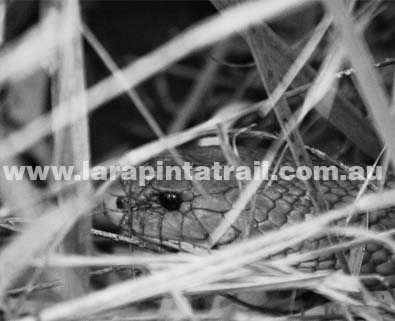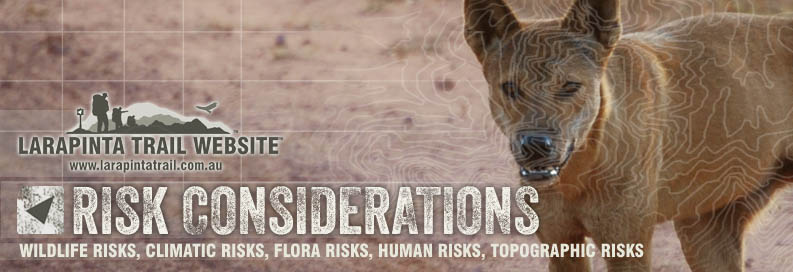 |
|
| One of the most underestimated risks by visitors to Central Australia ( and the Larapinta Trail) are the climatic risks. The Larapinta Trail is located in an arid region with extreme climatic conditions. This means it is a dry and hot area for most of the year. The best time to walk the Larapinta Trail is between May-August (June and July being ideal). Remember that you will be exposed to almost constant sunlight and UV exposure during the day in a low humidity and very dry environment. Fending off heat related injuries will be a constant consideration for most walkers. Take into consideration some of the following climatic risks to walkers: |
 |
Intense heat and/or sun exposure causing heat related injuries
|
 |
Freezing nights causing cold related injuries |
 |
Sunburn from lack of appropriate clothing and protection |
 |
Dehydration from lack of fluid intake |
 |
Injury sustained on trail may trigger other existing health conditions |
|
|
The topography ( terrain, gradients, going etc  ) of the Larapinta Trail varies, but there are three common elements to it: dry, rough and mountainous. The trail traverses over mountains, through narrow gorges and wide valleys and open flat plains. You can expect to trek over and along steep valleys which never seem to end and in many places, you can also expect to traverse over rough, rocky terrain with both fixed and loose rocks, boulders and shale. Take into consideration some of the following topographic risks to walkers: ) of the Larapinta Trail varies, but there are three common elements to it: dry, rough and mountainous. The trail traverses over mountains, through narrow gorges and wide valleys and open flat plains. You can expect to trek over and along steep valleys which never seem to end and in many places, you can also expect to traverse over rough, rocky terrain with both fixed and loose rocks, boulders and shale. Take into consideration some of the following topographic risks to walkers: |
 |
Rough ground that is loose with shale, rock and boulders
|
 |
A good portion of the trail is perfect ‘ankle busting terrain’ |
 |
Steep ascents and descents |
 |
Clambering over narrow gorges and waterfalls ('mostly dry ones!) |
 |
Traversing over mountains and along rough creek beds |
|
|
|
| The risks posed by wildlife along the Larapinta Trail is limited, BUT they can be dangerous and fatal. The highest risks are posed by snakes. The Larapinta Trail is home to some of Australia’s most poisonous snakes such as the King Brown ( pseudechis australis), but it is highly unlikely you will come across them, particularly during winter. If you do, exercise common sense and caution, but in most cases, just leave them be. |
| Another risk, albeit a low one, is Dingoes. They are most often heard and only occasionally seen. Many hikers have heard dingoes howl at night and have been spooked, but dingoes pose only a low risk to hikers. However, dingoes are not shy about visiting the campsites during the night and stealing any food, boots, equipment, cutlery, bags and other items of interest. They are superbly crafty, patient, stealthy and skilled animals. Secure all of your equipment at all times and NEVER leave any rubbish lying around. Finally, please NEVER feed wildlife on the trail. Take into consideration some of the following wildlife risks to hikers: |
 |
Highly venomous snakes |
 |
Insects (spiders, bull ants, ticks ) bites (i.e. causing allergic reactions) |
 |
Harassment by dingoes & by wild dogs – very unlikely |
|
|
| The majority of the flora along the Larapinta Trail poses little or no threat to hikers. The highest flora based risk is posed by ‘dead fall’ namely from River Redgums. They are a beautiful eucalypt tree common along the trail, particular along creek and river systems. Redgum branches, some weighting anywhere between 30-200kg (if not more) can drop without warning, meaning there is no sound such as a crack, splinter to indicate it is about to drop. Never camp underneath Redgum trees. Take into consideration some of the following flora risks to walkers: |
 |
Redgum trunks and branches drop without warning |
 |
Some plants along the trail are poisonous. Avoid trying 'bushtucker' |
 |
Spinifex needles are needle sharp and will easily puncture skin |
|
|
While very unlikely there is always a possibility that there may be people on the trail who may have an inclination to cause harm, distress or just be a plain nuisance to other hikers. To date, we have not heard of anything like this occurring, with the exception of general poor trail ethical behaviour, some theft of food from storage sheds and gear theft from campgrounds. But this is very rare.
|
| For hikers who plan to leave vehicles behind, keep in mind that these vehicle areas can be accessed by anyone, therefore there is an element of risk you need to be aware of. Hikers vehicles have been broken into, but again, it is not common. Take into consideration some of the following human risks to hikers: |
 |
Always secure your personal belongings. Don't leave gear lying around. |
 |
Don’t leave valuables in your vehicle
|
 |
If you notice any suspicious behaviour, report it immediately or ASAP |
 |
Advise other walkers of suspicious behaviour |
|
|




